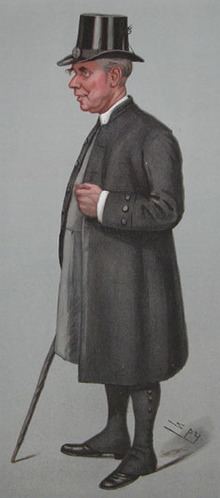Installed 1903 Name Randall Davidson Children None | Spouse Edith Tait Term ended 1928 | |
 | ||
Birth name Randall Thomas Davidson Died May 25, 1930, London, United Kingdom Books The Life Of Archibald Campbell Tait | ||
Randall Thomas Davidson, 1st Baron Davidson of Lambeth, (7 April 1848 – 25 May 1930) was an Anglican bishop of Scottish origin who served as Archbishop of Canterbury from 1903 to 1928.
Contents
Background and education
Davidson was the son of Henry Davidson, a grain merchant, of Edinburgh and Henrietta, daughter of John Campbell Swinton of Kimmerghame; his parents were Scottish Presbyterians. His education was mostly in small private schools that he later described as unsatisfactory and long lamented his lack of proficiency in Latin and Greek. Later, he studied at Harrow, where Brooke Foss Westcott was his final year housemaster, and at Trinity College, Oxford. In his final year of schooling, he was involved in a shooting accident that threatened the loss of his leg. According to his own account, it was only much later in his life, after the discovery and use of X-ray technology, that it was found that a considerable number of shotgun pellets still remained in his body. The accident left him with a hernia and he was a lifelong truss wearer, this caused him continuous difficulty as the hernia regularly dropped, especially when he was preaching.
Ministry
Davidson served as chaplain to Archibald Campbell Tait when Tait was Archbishop of Canterbury. He later married Tait's daughter. After Tait's death, Davidson remained at Lambeth Palace as chaplain to the succeeding Archbishop of Canterbury, Edward White Benson. A favourite of Queen Victoria, Davidson was appointed Dean of Windsor at a very young age. The Queen relied heavily on him for advice regarding church appointments and only reluctantly agreed to his preferment to episcopal office. He was nominated, elected, and confirmed as Bishop of Rochester before his episcopal ordination by Archbishop Benson, on St Mark's day (25 April) 1891 at Westminster Abbey. He later served as Bishop of Winchester between 1895 and 1903. Randall was also Clerk of the Closet from 1891 to 1903. As such, he played a major part in the funeral ceremonies for Queen Victoria in February 1901, taking care, along with James Reid, of the wake at Osborne House, Isle of Wight; and in the Coronation of King Edward VII and Queen Alexandra in August 1902. After successfully taking part in the coronation, he was invested as a Knight Commander of the Royal Victorian Order (KCVO) two days after the ceremony, on 11 August 1902.
Archbishop of Canterbury
Davidson was appointed Archbishop of Canterbury in 1903 and remained in office until his resignation in 1928. He was the longest holder of the office since the English Reformation. He was also the first Archbishop of Canterbury to retire, all his predecessors having died in office. Roger Lloyd, Church of England historian, thought that Davidson was one of the two or three greatest Archbishops of Canterbury. Others have remarked that Davidson's memory for people was prodigious.
Davidson reacted to the papal bull Apostolicae curae by stressing "the strength and depth of the Protestantism of England" and regarded other differences with Rome as much more important than its views on Anglican orders. This view seems to have been widely held at the time, judging from the reaction of Cardinal Herbert Vaughan, Roman Catholic Archbishop of Westminster.
On 25 October 1919 Davidson reluctantly agreed to receive a delegation of the South African National Native Congress (later the African National Congress or ANC) led by Solomon Plaatje who came to England to petition the imperial government against the notorious 1913 Natives' Land Act in South Africa. The meeting at Lambeth Palace was made possible by the intervention of The Rev John Harris, energetic organising secretary of the Anti-Slavery Society (APS). Behind the scenes Harris was advised by Davidson that he "should wish it, however, to be perfectly clear that the interview has no official character, that it must be regarded as absolutely private, and that no account of it must appear in print.' This, Davidson clearly emphasised was to 'avoid any misunderstanding his position in such matters'. Davidson warned Harris in no uncertain words that he must not be expected to give an answer of any formal kind whatsoever. For the SANNC, the interview with Davidson was a great disappointment. Not only was Davidson pressed for time, but not in the least willing to speak out against the hardship brought about by 1913 Natives' Land Act.
Davidson presided over two Lambeth Conferences and was present at five of the first six, Bell's biography suggests that at least part of the reason for his resignation was his natural reluctance to face the work and worry of the seventh conference, eventually held in 1930. Davidson resigned after Prayer Book revision failed to pass the House of Commons in 1928. As there was no procedure for resignation a commission of three bishops was hastily appointed to receive his letter of resignation and convey it to the King.
Honours
Davidson was appointed a Knight Commander of the Royal Victorian Order (KCVO) on 11 August 1902, a Privy Counsellor in 1903 and a Knight Grand Cross of the Royal Victorian Order (GCVO) in 1904. Davidson was also awarded the Royal Victorian Chain for his service as Archbishop of Canterbury.
Personal life
Davidson married Edith, daughter of Archibald Campbell Tait, Archbishop of Canterbury, in 1878. They had no children. His nephew and godson was the poet Randall Swingler. He died in May 1930, aged 82, when his barony as Lord Davidson of Lambeth became extinct. His wife died in June 1936. Both are buried in the cloister garden at Canterbury Cathedral.
